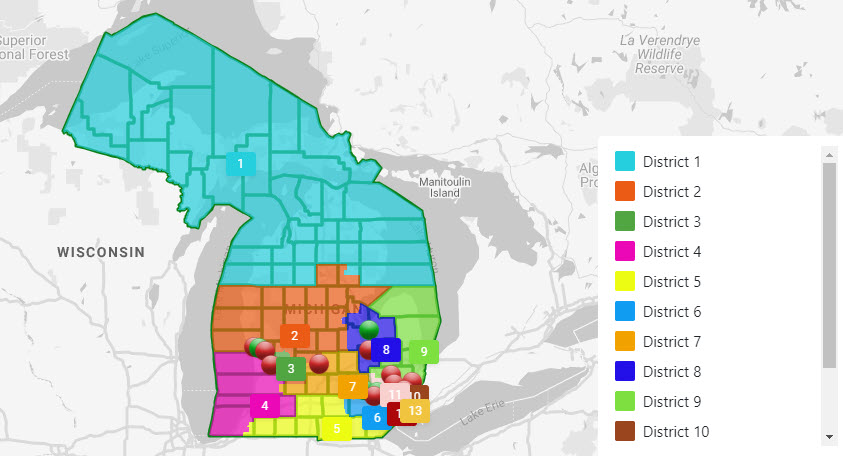A new Michigan State University analysis of the latest maps redrawing Michigan’s congressional and legislative districts called Monday for attention to increasing population equality across districts, addressing remaining Voting Rights Act compliance concerns, especially in Detroit, and articulating how communities of interest were selected for protection in the maps.
In its newly revised 163-page report, MSU’s Institute for Public Policy and Social Research (IPPSR) reviewed maps outlining proposed U.S. Congress,  Michigan House of Representatives and Michigan Senate boundaries to be followed by candidates and voters for the next decade. Read IPPSR Redistricting Map and Analysis V2.1 at https://ippsr.msu.edu/redistricting.
Michigan House of Representatives and Michigan Senate boundaries to be followed by candidates and voters for the next decade. Read IPPSR Redistricting Map and Analysis V2.1 at https://ippsr.msu.edu/redistricting.
The Michigan Independent Citizens Redistricting Commission approved the proposed maps, which can be seen here, last week, and is expected to submit them this week for 45 days of public comment. The Commission is due to meet next Thursday in Ann Arbor, Dec. 2 in Lansing, Dec. 16 in Detroit and Dec. 30 in Lansing where a final vote is scheduled.
IPPSR assessed nine collaboratively drawn Commission plans and some offered by individual Commission members. IPPSR made eight recommendations and stressed that its observations represented suggestions for consideration as the Commission moves toward final maps. It also noted that the Commission had addressed earlier recommendations in part.
“The next step is to achieve that shared vision for an improved redistricting process,” said Dr. Matt Grossmann, IPPSR director who spearheaded the review.
In Monday’s report, IPPSR found:
- IPPSR recommended the Commission increase population equality across districts in all of its proposed congressional redistricting plans. One of three Commission congressional redistricting plans scored better in meeting constitutional criteria.
- All commission-drawn plans governing the Michigan Senate split the city of Detroit into districts with less than 45 percent African-American population. The districts, to meet the federal Voting Rights Act should consider a map submitted by Commissioner Brittni Kellom and elevate it to an official collaborative Proposed map.
- The Commission may improve its maps’ legal standing with a written memo to justify any population inequality and describe its approach to selecting among Communities of Interest and pursuing Voting Rights Act compliance.
- Commission-drawn proposed state House districts are likely to lead to more Democratic seats than plans drawn by computers for comparison purposes. The maps, however, perform well on other measures of partisan fairness. In the final plan, the Commission should look to a broader set of accepted measures of partisan fairness, including those that courts have followed in rulings in partisan gerrymandering cases.
New Commission-drawn boundaries would take effect for 2022 elections, barring legal challenges.
Dr. Jon Eguia, Ph.D., MSU Professor of Economics, is lead author of the report written in cooperation in cooperation with redistricting researchers across the state and nation. It incorporates mathematical formulas that allow for the Commission and public to view district shapes and location assessed by seven specific requirements.
Those requirements call for districts to be of equal population, contiguous, reflect the state’s diverse population, not give advantage to any one political party, not favor incumbents, reflect local boundaries and be reasonably compact. Michigan voters approved the requirements in a state constitutional amendment in 2018. The amendment also called for the 13-member Commission to redraw state districts.
Dr. Eguia acknowledged the difficulty of redistricting, especially where legal requirements may appear to conflict. “We recommend that the commission take a broadened view, consider re-reviewing some decisions and refine others to take earlier court decisions into account,” he said.
Hear Dr. Eguia and Dr. Grossmann comment further on redistricting in IPPSR’s latest State of the State Podcast.
Some maps, the report noted, yet await analysis. Please see ippsr.msu.edu/redistricting as analysis is updated. In addition to the initial analysis, IPPSR plans a full report of Michigan’s new redistricting initiative in summer 2022.
IPPSR is reviewing the state’s redistricting effort plus providing training and technical assistance to the Redistricting Commission under a two-year, $250,000 grant from The Joyce Foundation of Chicago. Under the grant, IPPSR is working with the University of Michigan’s Center for Local, State, and Urban Policy (CLOSUP), to sharing resources, conducting educational programming and evaluating the redistricting initiative.
IPPSR is a campus center for policy analysis, political leadership development and training and survey research. It is home to the Michigan Political Leadership Program, Office for Survey Research and Correlates of State Policy database for students, faculty and researchers.
CLOSUP, the Center for Local State and Urban Policy at the University of Michigan’s Gerald R. Ford School of Public Policy, conducts, supports and fosters applied academic research to improve understanding of local, state, and urban policy issues.